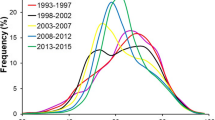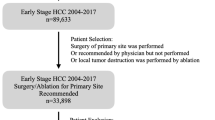Abstract
Background
Most patients with hepatocellular carcinoma (HCC) are ≥ 65 years old at diagnosis and ~ 20% present with disease amenable to curative intent surgical therapy. The aim of this study was to examine whether treatment, the demographic variables, and clinical factors could predict 5-year survival among HCC patients.
Methods
We included patients, 66 years or older, diagnosed with a first primary HCC from 1994 through 2007 in the SEER-Medicare database, and followed up until death or 31 December 2012. Curative intent treatment was defined as liver transplantation, surgery resection, or ablation. We estimated odds ratios (OR) and 95% confidence intervals (CI) for associations with 5-year survival using logistic regression.
Results
We identified 10,826 patients with HCC with mean age 75.3 (standard deviation, 6.4) years. Most were male (62.2%) and non-Hispanic white (59.7%). Overall, only 8.1% of patients were alive 5 years post-HCC diagnosis date. Among all patients that survived ≥ 5 years, 69.8% received potentially curative treatment. Conversely, patients who received potentially curative treatment represented only 15.7% of patients who survived < 5 years. Curative intent treatment was the strongest predictor for surviving ≥ 5 years (vs. none/palliative treatment; adjusted OR 8.12, 95% CI 6.90–9.64). While stage at diagnosis and comorbidities were also independently associated with ≥ 5-year survival in HCC patients, these factors did not improve discrimination between short- and long-term survivors.
Conclusions
Curative intent treatment was the strongest predictor for survival ≥ 5 years among HCC patients. Given the limited availability of liver transplant and limited eligibility for surgical resection, finding curative intent HCC therapies remain critically important.


Similar content being viewed by others
References
Altekruse SF, McGlynn KA, Reichman ME (2009) Hepatocellular carcinoma incidence, mortality, and survival trends in the United States from 1975 to 2005. J Clin Oncol 27(9):1485–1491. https://doi.org/10.1200/jco.2008.20.7753
Forner A, Llovet JM, Bruix J (2012) Hepatocellular carcinoma. Lancet 379(9822):1245–1255. https://doi.org/10.1016/s0140-6736(11)61347-0
White DL, Thrift AP, Kanwal F, Davila J, El-Serag HB (2017) Incidence of hepatocellular carcinoma in all 50 United States, from 2000 through 2012. Gastroenterology 152(4):812–20.e5. https://doi.org/10.1053/j.gastro.2016.11.020
Zhang X, El-Serag HB, Thrift AP (2019) Sex and race disparities in the incidence of hepatocellular carcinoma in the United States examined through age-period-cohort analysis. Cancer Epidemiol Biomark Prev. https://doi.org/10.1158/1055-9965.Epi-19-1052
Wang Z, Gu X, Thrift AP (2019) Factors associated with favorable survival outcomes for Asians with hepatocellular carcinoma: a sequential matching cohort study. PLoS ONE 14(4):e0214721. https://doi.org/10.1371/journal.pone.0214721
Marrero JA, Kulik LM, Sirlin CB, Zhu AX, Finn RS, Abecassis MM et al (2018) Diagnosis, staging, and management of hepatocellular carcinoma: 2018 practice guidance by the American association for the study of liver diseases. Hepatology (Baltimore, MD) 68(2):723–750. https://doi.org/10.1002/hep.29913
Lencioni R, Chen XP, Dagher L, Venook AP (2010) Treatment of intermediate/advanced hepatocellular carcinoma in the clinic: how can outcomes be improved? Oncologist 15(Suppl 4):42–52. https://doi.org/10.1634/theoncologist.2010-S4-42
Raza A, Sood GK (2014) Hepatocellular carcinoma review: current treatment, and evidence-based medicine. World J Gastroenterol 20(15):4115–4127. https://doi.org/10.3748/wjg.v20.i15.4115
Lin S, Hoffmann K, Schemmer P (2012) Treatment of hepatocellular carcinoma: a systematic review. Liver Cancer 1(3–4):144–158. https://doi.org/10.1159/000343828
Lurje I, Czigany Z, Bednarsch J, Roderburg C, Isfort P, Neumann UP et al (2019) Treatment strategies for hepatocellular carcinoma—a multidisciplinary approach. Int J Mol Sci 20(6):1465
Kow AWC (2019) Transplantation versus liver resection in patients with hepatocellular carcinoma. Transl Gastroenterol Hepatol 4:33. https://doi.org/10.21037/tgh.2019.05.06
NCCN Clinical Practice Guidelines in Oncology (NCCN Guidelines®); Hepatobiliary Cancers, Version 2. National Comprehensive Cancer Network, 2015.
Warren JL, Klabunde CN, Schrag D, Bach PB, Riley GF (2002) Overview of the SEER-Medicare data: content, research applications, and generalizability to the United States elderly population. Med Care. https://doi.org/10.1097/01.Mlr.0000020942.47004.03
Bruix J, Sherman M (2011) Management of hepatocellular carcinoma: an update. Hepatology (Baltimore, MD) 53(3):1020–1022. https://doi.org/10.1002/hep.24199
Kaplan EL, Meier P (1958) Nonparametric estimation from incomplete observations. J Am Stat Assoc 53(282):457–481. https://doi.org/10.1080/01621459.1958.10501452
Cox DR (1972) Regression models and life-tables. J Roy Stat Soc 34(2):187–220
Zou KH, O’Malley AJ, Mauri L (2007) Receiver-operating characteristic analysis for evaluating diagnostic tests and predictive models. Circulation 115(5):654–657. https://doi.org/10.1161/CIRCULATIONAHA.105.594929
Usage Note 39724: ROC analysis using validation data and cross validation. In: SAS 2020. https://support.sas.com/kb/39/724.html. Accessed 11 Jan 2020.
Yung Y-F, Lamm M, Zhang W (2018) Causal mediation analysis with the CAUSALMED procedure. SAS Institute Inc. https://www.sas.com/content/dam/SAS/support/en/sas-global-forum-proceedings/2018/1991-2018.pdf.
Richiardi L, Bellocco R, Zugna D (2013) Mediation analysis in epidemiology: methods, interpretation and bias. Int J Epidemiol 42(5):1511–1519. https://doi.org/10.1093/ije/dyt127
Ulahannan SV, Duffy AG, McNeel TS, Kish JK, Dickie LA, Rahma OE et al (2014) Earlier presentation and application of curative treatments in hepatocellular carcinoma. Hepatology (Baltimore, MD) 60(5):1637–1644. https://doi.org/10.1002/hep.27288
Shaya FT, Breunig IM, Seal B, Mullins CD, Chirikov VV, Hanna N (2014) Comparative and cost effectiveness of treatment modalities for hepatocellular carcinoma in SEER-medicare. Pharmacoeconomics 32(1):63–74. https://doi.org/10.1007/s40273-013-0109-7
Shah SA, Smith JK, Li Y, Ng SC, Carroll JE, Tseng JF (2011) Underutilization of therapy for hepatocellular carcinoma in the medicare population. Cancer 117(5):1019–1026. https://doi.org/10.1002/cncr.25683
Golabi P, Fazel S, Otgonsuren M, Sayiner M, Locklear CT, Younossi ZM (2017) Mortality assessment of patients with hepatocellular carcinoma according to underlying disease and treatment modalities. Medicine 96(9):e5904. https://doi.org/10.1097/md.0000000000005904
Shah C, Mramba LK, Bishnoi R, Bejjanki H, Chhatrala HS, Chandana SR (2017) Survival differences among patients with hepatocellular carcinoma based on the stage of disease and therapy received: pre and post sorafenib era. J Gastrointest Oncol 8(5):789–798. https://doi.org/10.21037/jgo.2017.06.16
Wang C-Y, Li S (2019) Clinical characteristics and prognosis of 2887 patients with hepatocellular carcinoma: a single center 14 years experience from China. Medicine 98(4):e14070e. https://doi.org/10.1097/MD.0000000000014070
Liu P-H, Hsu C-Y, Hsia C-Y, Lee Y-H, Huang Y-H, Su C-W et al (2016) Proposal and validation of a new model to estimate survival for hepatocellular carcinoma patients. Eur J Cancer 63:25–33. https://doi.org/10.1016/j.ejca.2016.04.023
Johnson P, Berhane S, Kagebayashi C, Satomura S, Teng M, Fox R et al (2017) Impact of disease stage and aetiology on survival in hepatocellular carcinoma: implications for surveillance. Br J Cancer 116(4):441–447. https://doi.org/10.1038/bjc.2016.422
Brown JC, Meyerhardt JA (2016) Obesity and energy balance in GI cancer. J Clin Oncol 34(35):4217–4224. https://doi.org/10.1200/JCO.2016.66.8699
Poon RT, Fan ST, Lo CM, Liu CL, Ng IO, Wong J (2000) Long-term prognosis after resection of hepatocellular carcinoma associated with hepatitis B-related cirrhosis. J Clin Oncol 18(5):1094–1101. https://doi.org/10.1200/jco.2000.18.5.1094
Nathan H, Hyder O, Mayo SC, Hirose K, Wolfgang CL, Choti MA et al (2013) Surgical therapy for early hepatocellular carcinoma in the modern era: a 10-year SEER-medicare analysis. Ann Surg 258(6):1022–1027. https://doi.org/10.1097/SLA.0b013e31827da749
Chen VL, Le AK, Kim NG, Kim LH, Nguyen NH, Nguyen PP et al (2016) Effects of cirrhosis on short-term and long-term survival of patients with hepatitis B-related hepatocellular carcinoma. Clin Gastroenterol Hepatol 14(6):887–95.e1. https://doi.org/10.1016/j.cgh.2015.12.044
Kuo K-L, Stenehjem D, Albright F, Ray S, Brixner D (2015) Treatment patterns and outcomes in patients with hepatocellular carcinoma stratified by stage-guided treatment categories. J Natl Compr Canc Netw 13(8):987. https://doi.org/10.6004/jnccn.2015.0119
Fujii H, Itoh Y, Ohnishi N, Sakamoto M, Ohkawara T, Sawa Y et al (2012) Factors associated with the overall survival of elderly patients with hepatocellular carcinoma. World J Gastroenterol 18(16):1926–1932. https://doi.org/10.3748/wjg.v18.i16.1926
Curative vs. palliative chemotherapy and radiation therapy (RT). In: Measures that are Limited or not Available in the Data. U.S. Department of Health & Human Services, National Cancer Institute, Division of Cancer Control and Population Sciences. 2019. Accessed 04 May 2020.
Funding
X. Zhang was supported by a research training grant from the Cancer Prevention and Research Institute of Texas (CPRIT; RP160097). H.B. El-Serag was supported by NIDDK K24-04-107.
Author information
Authors and Affiliations
Contributions
XZ, HBE, APT: Conception and design, Development of methodology, Analysis and interpretation of data (e.g., statistical analysis, biostatistics, computational analysis), Writing, review, and/or revision of the manuscript. APT: Acquisition of data (provided animals, acquired and managed patients, provided facilities, etc.), Study supervision. XZ, HBE: Administrative, technical, or material support (i.e., reporting or organizing data, constructing databases). All authors approved the final version of the manuscript.
Corresponding author
Ethics declarations
Conflict of interest
The authors declare that they have no conflict of interest.
Additional information
Publisher's Note
Springer Nature remains neutral with regard to jurisdictional claims in published maps and institutional affiliations.
Supplementary information
Below is the link to the electronic supplementary material.
Rights and permissions
About this article
Cite this article
Zhang, X., El-Serag, H.B. & Thrift, A.P. Predictors of five-year survival among patients with hepatocellular carcinoma in the United States: an analysis of SEER-Medicare. Cancer Causes Control 32, 317–325 (2021). https://doi.org/10.1007/s10552-020-01386-x
Received:
Accepted:
Published:
Issue Date:
DOI: https://doi.org/10.1007/s10552-020-01386-x




